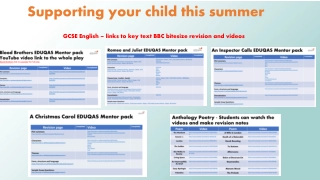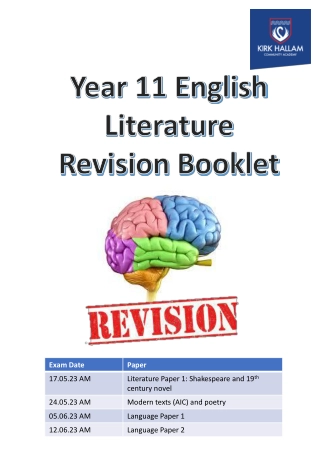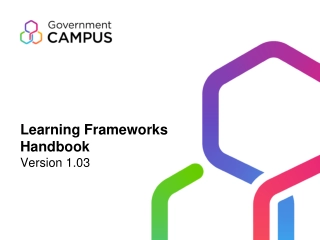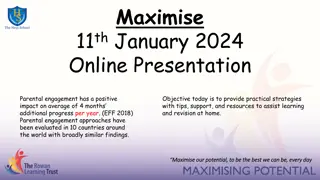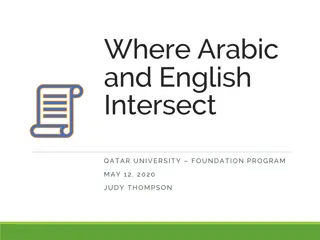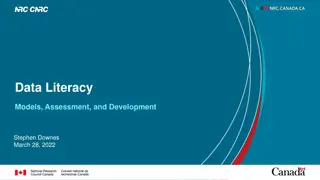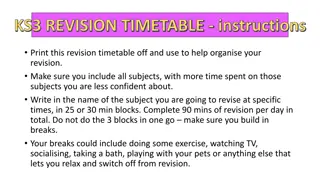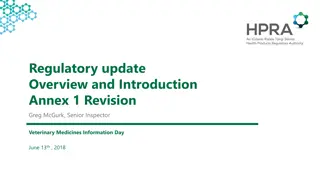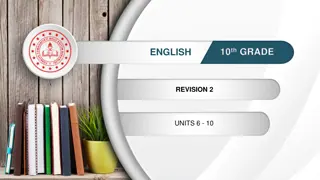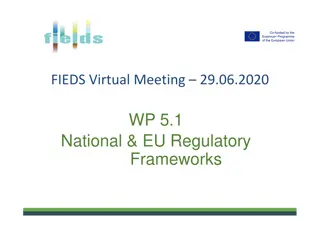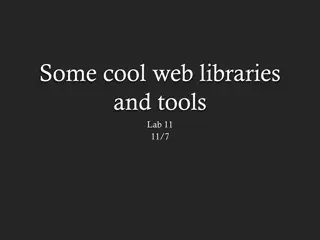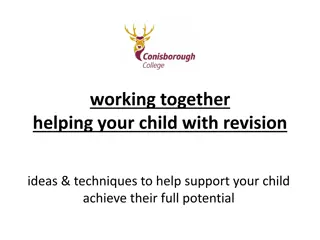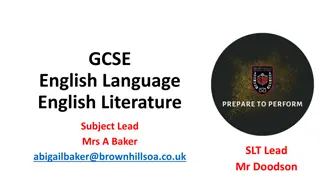Language Frameworks and Analysis Basics for English Revision
This content provides a comprehensive overview of language frameworks for English revision, including analyzing text using GRASP method, understanding main language frameworks like lexis, semantics, grammar, phonology, pragmatics, graphology, and discourse, and details on word classes like nouns, adjectives, verbs, adverbs, pronouns, conjunctions, prepositions, and determiners.
Download Presentation

Please find below an Image/Link to download the presentation.
The content on the website is provided AS IS for your information and personal use only. It may not be sold, licensed, or shared on other websites without obtaining consent from the author. Download presentation by click this link. If you encounter any issues during the download, it is possible that the publisher has removed the file from their server.
E N D
Presentation Transcript
AS English Language Revision { Language Frameworks The Basics
Analysing a Text - GRASP When given a piece of discourse, identify: Genre what kind of text it is e.g. leaflet, formal speech, newspaper article Register type of language used that s appropriate for the audience/context. Can also relate to the formality of the discourse Audience the listener or reader, how they are addressed (indirect, direct, formally, informally) Subject Matter what the discourse is about, this will influence the lexical choices and semantic field of the language Purpose what the speaker/writer is trying to achieve (inform, persuade, instruct or entertain)
Seven Main Language Frameworks The vocabulary of a language There will be words within a text which share a similar topic or focus which is called a lexical field Lexis The study of how meaning is created through words and phrases A word will have literal meaning as well as an associated one e.g. red the colour also connotes danger or love Semantics System of rules that governs how words and sentences are constructed. There are 3 main parts to grammar: A system that groups words into classes according to their function e.g. verbs, adjectives, nouns etc. A system of rules about how these types of words function in relation to each other (syntax) The individual units that make up whole words (morphology) Grammar 1. 2. 3. Study of sounds how they re pronounced and how they re combined to make words This includes non-verbal aspects of speech or prosody features of spoken language such as pace, stress, rhythm and intonation Phonology Also known as language in use. Its about how social conventions, context, personality and relationships influence the choices people make about their language Pragmatics Study of appearance of the writing and the effect this has on a text Describe and analyse features such as typeface, position of it on the page and the relationships between text and images Graphology An extended piece of spoken or written language made up of more than one utterance (in spoken language) and more than one sentence (in written language) Discourse
Grammar Word Classes Word Class Function Example Nouns naming words person, place or thing 3 types concrete, abstract and proper London, book, Jill, romance Adjectives Describing words often nouns but sometimes pronouns Large, sunny, pretty Verbs Doing words Jump, read, eat Adverbs Describe verbs (and sometimes adjectives and other adverbs) Steadily, incredibly, sadly Pronouns Take the place of nouns You, they, him, me, it Conjunctions Connecting words And, or, but because Prepositions Define relationships between words in terms of time, space and direction Before, underneath, next to Determiners Give specific kinds of information about a noun (e.g. quantity or possession) A, the, two, his, few, those
Proper Nouns Names of specific people (e.g. William, Patel) Names of specific places (e.g. Paris) Names of specific brands (addidas, Reebok) Nouns Concrete Things you can physically touch or see (e.g. rock, table, ship) Abstract Common Nouns Concepts e.g. truth States e.g. childhood Qualities e.g. honesty Emotions e.g. - sadness Collective Groups of people, animals or things (e.g. government, team, audience
Nouns continued Count nouns and Mass nouns Count nouns can be counted e.g. brick (one brick, two bricks etc.) Nouns that form irregular plurals can be count nouns too (one mouse, two mice etc.) Mass nouns can t be counted, don t have a plural e.g. information Some nouns can function as both, depending on context e.g. war is evil (mass noun, war in general) the war is evil (count noun, specific war) Modifying Nouns Pre-modifiers come before the noun, can have more than one e.g. the dangerous bear or the very dangerous bear Post-modifiers come after the noun e.g. examination in progress
Adjectives Adjectives are classified according to their position within the sentence before or after the noun Attributive adjectives are pre-modifying e.g. the sudden noise Predicative adjectives are post-modifying. They re usually linked to the noun they are modifying by the form of the verb to be: 1. 2. Revision is brilliant the adjective is linked to the noun by a form of the verb to be The food looked amazing although forms of to be are the most common links, other verbs can link the adjective to the noun (e.g. looked, seemed, felt)
Adjectives continued Adjectives are gradable they show how much of a certain property a noun displays Comparative adjectives formed by adding an er inflection Superlative adjectives formed by adding est, it is the highest amount of quality that a noun can display e.g. finest, biggest, greatest Some adjectives are irregular in the way they form comparatives and superlatives e.g. good -> better -> best Some adjectives need more or most to form comparisons e.g. more significant, most significant 1. 2. 3. 4.
Verbs The base form of a verb is called the infinitive Main verbs (lexical verbs) identify the action of the sentence e.g. she sings like a hyena, he gave me his shoe Auxiliary verbs go before the main verb in a sentence. They give extra information about the main verb and can affect the meaning of the sentence and there are to types: Primary auxiliary 3 primary auxiliaries: do, have and be. They can be the main verb. Modal auxiliary Can only occur with reference to a main verb. There are 9 modal auxiliaries: can, could, will, would, must, may, might, shall and should 1. 2.
Verbs continued Person Singular Pronoun Verb Plural Pronoun Verb First I Play We play Second You Play You Play Third She/He/It Plays They Play Most verbs are regular they follow the same patterns as above Irregular verbs don t change like you d expect e.g. I drink becomes I drank not I drinked To be is very irregular it changes more than any other verb according to person, number or tense
Active & Passive Voice Active voice the subject is the focus and performs the action described by the verb Sally kicked the ball the subject (Sally) acts directly upon the object (the ball) and it receives the action of the verb Passive voice focuses on the object and the order changes so that the object comes first. It doesn t always include the subject if the verb has implications of who did it e.g. Cuts made to NHS The ball was kicked by Sally - the passive voice is more formal
Adverbs Used to modify verbs but can modify nouns and adjectives too Adverbs of manner how something is done e.g. he talks incessantly Adverbs of place where something is happening e.g. the book is here Adverbs of time when something is happening e.g. the exam is tomorrow Adverbs of duration how long something happens for e.g. the bridge is temporarily closed Adverbs of frequency how often something takes place e.g. Mandy visits sometimes Adverbs of degree the extent to which something is done e.g. We completely understand Some adverbs express feelings They can link sentences together e.g. the man was a great athlete however
Prepositions & Conjunctions Prepositions show relationships between things in terms of space, time or direction. Usually goes before the determiner or noun e.g. the books are underneath the bed, she left before the end, he moved towards the door Conjunctions are linking words and there are two types co-ordinating and subordinating Co-ordinating conjunctions such as and, but, or connect single words or longer units of language (phrases or clauses) that have equal status e.g. Bethany and Robert, A white shirt or a pink shirt Subordinating conjunctions such as since, although, because, unless and whereas link the main clause to one of less importance to the subject within the sentence e.g. Some people find maths difficult whereas others find it easy. Other subordinating conjunctions give different meanings such as after, before and until are to do with time and where and wherever are about place
Clauses There are 7 types of clause which are made from different combinations of subject (S), verb (V), object (O), complement (C) and adverbial (A) S + V Harry + played S + V + O Harry + played + a game S + V + C Harry + was + great S + V + A Harry + played + on Tuesday S + V + O + O Harry + gave + him + a drink S + V + O + C Harry + thought + his performance + disappointing S + V + O + A Harry + passed + the ball + quickly
Clauses continued The status of a clause depends on its constituents and whether it can stand alone as a meaningful unit of language Main clauses can stand alone and still make sense e.g. Harry played Co-ordinate clauses occur in sentences where there are two or more independent clauses. They re joined together by a co-ordinating conjunction like and or but e.g. The band played for two hours but I had to leave early. The clauses could stand alone and still make sense. Subordinate clauses can t stand alone, they have to be with a main clause. It gives extra information about the main clause and usually led by a sub-ordinate conjunction e.g. will you pop in to see me while you re here tomorrow? Combining clauses a combination of a co-ordinate clause and a subordinate clause in the same sentence e.g. He went to London and she went to Manchester because of a terrible row
Sentence Type There are five types of sentence minor, simple, compound, complex and compound-complex. The length and complexity of the sentences can be varied according to the context and the audience. Minor sentences - complete and meaningful statements that don t have a subject and verb combination e.g. Silence Simple sentences must have a subject and a verb and express a complete thought e.g. the snow falls Compound sentence an independent clause linked to another by a co-ordinating conjunction e.g. I went to Manchester and I went to Liverpool Complex sentence consists of a main clause and a subordinate clause(s). A subordinating conjunction joins the two e.g. the workers left the building when they heard Compound-complex made up of at least two co-ordinate clauses connected by a co-ordinating conjunction and at least one subordinate clause e.g. some of the children went home early but others remained because they had no transport 1. 2. 3. 4. 5.
Sentence Function/Mood There are four sentence functions: Declarative - to give information e.g. I like cheese Imperative to give orders, instructions, advice and directions e.g. Answer one question from each section They start with a main verb and don t have a subject Interrogative to ask questions e.g. are you coming out tonight? Some questions are formed by inverting the verb and subject. They can start with wh- words (where, who, what, why, when) They can be added to the end of a statement to create a tag question In spoken discourse, you can turn declarative statements into questions using stress and a rising intonation Exclamatives to express an opinion or feeling e.g. that was fantastic!



